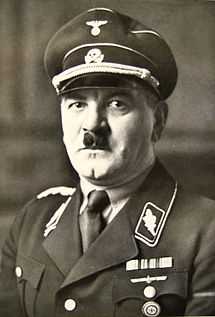Julius Schreck

Julius Schreck (13 July 1898 – 16 May 1936) was an early Nazi Party member, one of Hitler's closest bodyguards, a founding member of the Sturmabteilung (SA) and also the first commander of the Schutzstaffel (SS). He died in May 1936 and was given a state funeral.
Life
He was born in Munich and later served in the German Army during World War I. After the war in 1919, he became a member of Freikorps Epp. Schreck was an early member of the Nazi Party having joined in 1920 (member number 53). He developed a deep friendship with Adolf Hitler in the early days of Nazi history.[1]
In 1921 Schreck was one of the founders of the Sturmabteilung (SA). Hitler, in early 1923, ordered the formation of a small separate bodyguard dedicated to his service rather than "a suspect mass" of the party, such as the SA.[2] Originally the unit was composed of only eight men, commanded by Julius Schreck and Joseph Berchtold.[3] It was designated the Stabswache (Staff Guard).[4] The Stabswache were issued unique badges, but at this point the Stabswache was still under overall SA control. Schreck resurrected the use of the Totenkopf (death's head) as the unit's insignia, a symbol various elite forces had used in the past, including specialized assault troops of Imperial Germany in World War I who used Hutier infiltration tactics.[5]
Later that year, the unit was renamed Stoßtrupp (Shock Troop) 'Adolf Hitler'.[5] On 9 November 1923 the Stoßtrupp, along with the SA and several other paramilitary units, took part in the abortive Beer Hall Putsch in Munich. In the aftermath of the putsch both Hitler, Schreck, and other Nazi leaders were incarcerated at Landsberg Prison.[6] The Nazi Party and all associated formations, including the Stoßtrupp, were officially disbanded.
After Hitler's release from prison on 20 December 1924, the Nazi Party was officially refounded. In 1925, Hitler ordered the formation of a new bodyguard unit, the Schutzkommando (protection command).[7] It was formed by Schreck and included old Stoßtrupp members, Emil Maurice and Erhard Heiden.[8][9] That same year, the Schutzkommando was expanded to a national level. It was renamed successively the Sturmstaffel (storm squadron), and finally the Schutzstaffel, abbreviated to SS (on 9 November).[10] Schreck became SS Member number 5.[6] He was asked by Hitler to command the bodyguard company and, as such, became the first Reichsführer-SS (although Schreck never referred to himself by this title).
In 1926, Schreck stood down as Reichführer-SS and Berchtold took over the leadership.[11] He remained on the SS rolls as an SS-Führer and worked as Hitler’s private chauffeur after Maurice.[12] In 1930, after the SS had begun to expand under Heinrich Himmler, Schreck was appointed as an SS-Standartenführer but had little actual power. He served at Hitler's side and they were on very good terms.[12]
In 1936, Julius Schreck developed meningitis and died on 16 May. He was honored in a Nazi state funeral with Adolf Hitler delivering his eulogy.[12]
Notes
- ↑ Hamilton 1984, pp. 172, 173.
- ↑ McNab 2009, pp. 14, 16.
- ↑ Weale 2010, p. 16.
- ↑ McNab 2009, p. 14.
- ↑ 5.0 5.1 McNab 2009, p. 16.
- ↑ 6.0 6.1 Hamilton 1984, p. 172.
- ↑ Lumsden 2002, p. 14.
- ↑ Weale 2010, pp. 16, 26.
- ↑ McNab 2009, pp. 10, 11.
- ↑ Weale 2010, p. 29.
- ↑ Weale 2010, p. 30.
- ↑ 12.0 12.1 12.2 Hamilton 1984, p. 173.
References
- Hamilton, Charles (1984). Leaders & Personalities of the Third Reich, Vol. 1. R. James Bender Publishing. ISBN 0-912138-27-0.
- Lumsden, Robin (2002). A Collector's Guide To: The Allgemeine — SS. Ian Allan Publishing, Inc. ISBN 0-7110-2905-9.
- McNab, Chris (2009). The SS: 1923–1945. Amber Books Ltd. ISBN 978-1-906626-49-5.
- Weale, Adrian (2010). The SS: A New History. London: Little, Brown. ISBN 978-1408703045.
External links
| Government offices | ||
|---|---|---|
| Preceded by new office |
Reich Leader of the SS 1925–1926 |
Succeeded by Joseph Berchtold |
| ||||||||||||||||||||||||||||||||||||||||||||||||||||||||
|
.svg.png)